AMD Ryzen 9 5980HS Cezanne Review: Ryzen 5000 Mobile Tested
by Dr. Ian Cutress on January 26, 2021 9:00 AM EST- Posted in
- CPUs
- AMD
- Vega
- Ryzen
- Zen 3
- Renoir
- Notebook
- Ryzen 9 5980HS
- Ryzen 5000 Mobile
- Cezanne
CPU Tests: Synthetic and SPEC
Most of the people in our industry have a love/hate relationship when it comes to synthetic tests. On the one hand, they’re often good for quick summaries of performance and are easy to use, but most of the time the tests aren’t related to any real software. Synthetic tests are often very good at burrowing down to a specific set of instructions and maximizing the performance out of those. Due to requests from a number of our readers, we have the following synthetic tests.
Linux OpenSSL Speed: SHA256
One of our readers reached out in early 2020 and stated that he was interested in looking at OpenSSL hashing rates in Linux. Luckily OpenSSL in Linux has a function called ‘speed’ that allows the user to determine how fast the system is for any given hashing algorithm, as well as signing and verifying messages.
OpenSSL offers a lot of algorithms to choose from, and based on a quick Twitter poll, we narrowed it down to the following:
- rsa2048 sign and rsa2048 verify
- sha256 at 8K block size
- md5 at 8K block size
For each of these tests, we run them in single thread and multithreaded mode. All the graphs are in our benchmark database, Bench, and we use the sha256 results in published reviews.
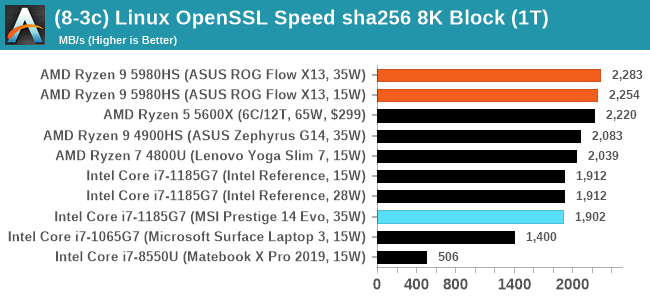
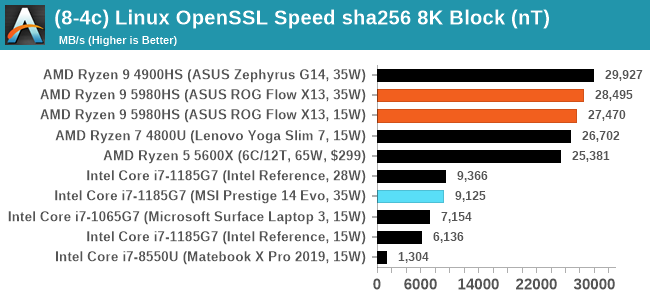
GeekBench 5: Link
As a common tool for cross-platform testing between mobile, PC, and Mac, GeekBench is an ultimate exercise in synthetic testing across a range of algorithms looking for peak throughput. Tests include encryption, compression, fast Fourier transform, memory operations, n-body physics, matrix operations, histogram manipulation, and HTML parsing.
Unfortunately we are not going to include the Intel GB5 results in this review, although you can find them inside our benchmark database. The reason behind this is down to AVX512 acceleration of GB5's AES test - this causes a substantial performance difference in single threaded workloads that thus sub-test completely skews any of Intel's results to the point of literal absurdity. AES is not that important of a real-world workload, so the fact that it obscures the rest of GB5's subtests makes overall score comparisons to Intel CPUs with AVX512 installed irrelevant to draw any conclusions. This is also important for future comparisons of Intel CPUs, such as Rocket Lake, which will have AVX512 installed. Users should ask to see the sub-test scores, or a version of GB5 where the AES test is removed.
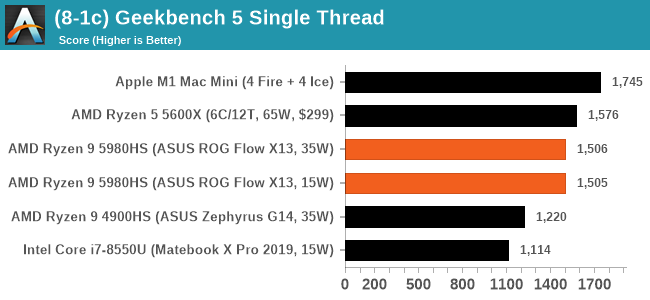

To clarify the point on AES. The Core i9-10900K scores 1878 in the AES test, while 1185G7 scores 4149. While we're not necessarily against the use of accelerators especially given that the future is going to be based on how many and how efficient these accelerators work (we can argue whether AVX-512 is efficient compared to dedicated silicon), the issue stems from a combi-test like GeekBench in which it condenses several different (around 20) tests into a single number from which conclusions are meant to be drawn. If one test gets accelerated enough to skew the end result, then rather than being a representation of a set of tests, that one single test becomes the conclusion at the behest of the others, and it's at that point the test should be removed and put on its own. GeekBench 4 had memory tests that were removed for Geekbench 5 for similar reasons, and should there be a sixth GeekBench iteraction, our recommendation is that the cryptography is removed for similar reasons. There are 100s of cryptography algorithms to optimize for, but in the event where a popular tests focuses on a single algorithm, that then becomes an optimization target and becomes meaningless when the broader ecosystem overwhelmingly uses other cryptography algorithms.
CPU Tests: SPEC
SPEC2017 and SPEC2006 is a series of standardized tests used to probe the overall performance between different systems, different architectures, different microarchitectures, and setups. The code has to be compiled, and then the results can be submitted to an online database for comparison. It covers a range of integer and floating point workloads, and can be very optimized for each CPU, so it is important to check how the benchmarks are being compiled and run.
We run the tests in a harness built through Windows Subsystem for Linux, developed by our own Andrei Frumusanu. WSL has some odd quirks, with one test not running due to a WSL fixed stack size, but for like-for-like testing is good enough. SPEC2006 is deprecated in favor of 2017, but remains an interesting comparison point in our data. Because our scores aren’t official submissions, as per SPEC guidelines we have to declare them as internal estimates from our part.
For compilers, we use LLVM both for C/C++ and Fortan tests, and for Fortran we’re using the Flang compiler. The rationale of using LLVM over GCC is better cross-platform comparisons to platforms that have only have LLVM support and future articles where we’ll investigate this aspect more. We’re not considering closed-sourced compilers such as MSVC or ICC.
clang version 10
clang version 7.0.1 (ssh://git@github.com/flang-compiler/flang-driver.git
24bd54da5c41af04838bbe7b68f830840d47fc03)
-Ofast -fomit-frame-pointer
-march=x86-64
-mtune=core-avx2
-mfma -mavx -mavx2
Our compiler flags are straightforward, with basic –Ofast and relevant ISA switches to allow for AVX2 instructions. We decided to build our SPEC binaries on AVX2, which puts a limit on Haswell as how old we can go before the testing will fall over. This also means we don’t have AVX512 binaries, primarily because in order to get the best performance, the AVX-512 intrinsic should be packed by a proper expert, as with our AVX-512 benchmark. All of the major vendors, AMD, Intel, and Arm, all support the way in which we are testing SPEC.
To note, the requirements for the SPEC licence state that any benchmark results from SPEC have to be labelled ‘estimated’ until they are verified on the SPEC website as a meaningful representation of the expected performance. This is most often done by the big companies and OEMs to showcase performance to customers, however is quite over the top for what we do as reviewers.
For each of the SPEC targets we are doing, SPEC2006 rate-1, SPEC2017 speed-1, and SPEC2017 speed-N, rather than publish all the separate test data in our reviews, we are going to condense it down into a few interesting data points. The full per-test values are in our benchmark database.
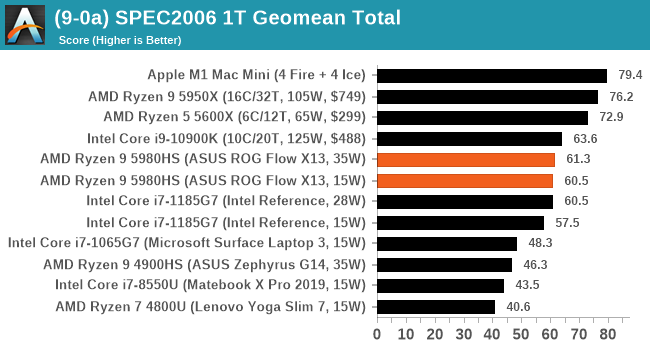
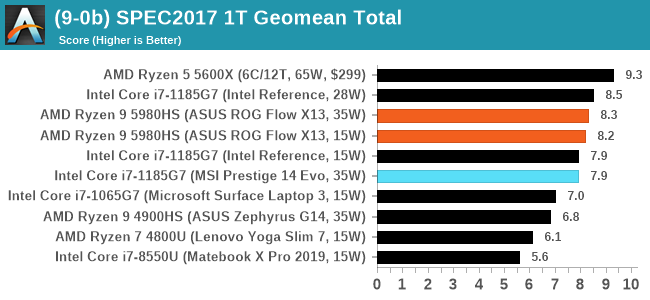











218 Comments
View All Comments
Spunjji - Monday, February 1, 2021 - link
I'm aware of all of the above, but it still doesn't justify the original claims being made - and "Potentially also on the menu would be a faster peak clock rate" is nothing but speculation. Based on what we know about the design and the relatively poor clock scaling in respect of TDP shown between the A14 and M1, I'd say it's extremely unlikely that Apple will be able to push clocks up by more than a couple of hundred megahertz without a significant redesign.What Apple will most likely have in that TDP range is something that's performance-competitive with Cezanne on the CPU side in native applications, significantly outclasses it on the GPU side, and maintains a perf/watt advantage commensurate with the node advantage that largely disappears when running translated code.
It's still far better than what Intel have, but it's not going to redefine the industry. If that order of advantage were enough to do so, then AMD wouldn't have existed after 2007.
GeoffreyA - Sunday, January 31, 2021 - link
"Apple will outclass everything x86 once they introduce their second gen silicon"I've noticed the idea circulating is that the M1 is Apple's first-generation CPU. Sure, it may be the first one going into a computer, but as far as I'm aware, the M1 descends from the A14, which goes back to the A6 of 2012. How many iterations is that? Nine? Granted, some might be "ticks," but this certainly isn't a brand-new design. Zen 3, despite borrowing from Athlon, Bulldozer, and Core, is on its 3rd iteration, or 4th if one counts Zen+.
Lucky Stripes 99 - Tuesday, January 26, 2021 - link
Not only have iGPUs cannibalized the sub-$100 discrete GPU market, but they have also chewed into the cool and quiet GPU market. If you have a HTPC or compact mITX system, your options aren't that great. I'd really like a GTX 3060L on a low profile PCIe card, but I won't hold my breath.Also, I love the return of the 16:10 screen format. I'd kill for a 27" desktop version of the X13's screen with the same resolution and color coverage.
DigitalFreak - Tuesday, January 26, 2021 - link
What's the problem with integrated graphics in a HTPC?Lucky Stripes 99 - Tuesday, January 26, 2021 - link
New features tend to come slower to iGPU parts than to discrete GPU parts. As example, it used to be very difficult to build a 4K60p system with a Raven Ridge APU because so few boards supported HDMI 2.0. Likewise, you're often stuck with an older video decoder/encoder than what is available on the discrete GPU market. Luckily the only feature missing from the latest generation of AMD parts is hardware AV1 decoding which will come with the RDNA2 APUs next round.dudedud - Tuesday, January 26, 2021 - link
I thought you will be including the M1 in more benchmarks besides GB and SPEC.:/
danwat1234 - Tuesday, January 26, 2021 - link
"But what is perhaps worrying is the temperature, being reported as a sustained 92-94ºC on average. That’s quite high. " --> 94C is fine, the silicon is rated to handle it 24/7. What is strange to me is that it most of the tests, the CPU temperature stays in the 80s, when there is more thermal headroom to go. It could clock higher.Fulljack - Wednesday, January 27, 2021 - link
80°C means either you have a glaring jet sound on your laptop fans or downclock it enough to keep it quite.Deicidium369 - Wednesday, January 27, 2021 - link
quite what?and pretty sure glaring refers to vision, while blaring refers to SPL
abufrejoval - Tuesday, January 26, 2021 - link
I wonder why you peg the mobile 8-core against a desktop 6-core instead of the 5800X...?Having the various 8-cores side-by-side allows a much better understanding of how architecture and power settings compare generally.
BTW tried do the manual comparison via Bench, but it seems the Chezanne results aren't in there yet.